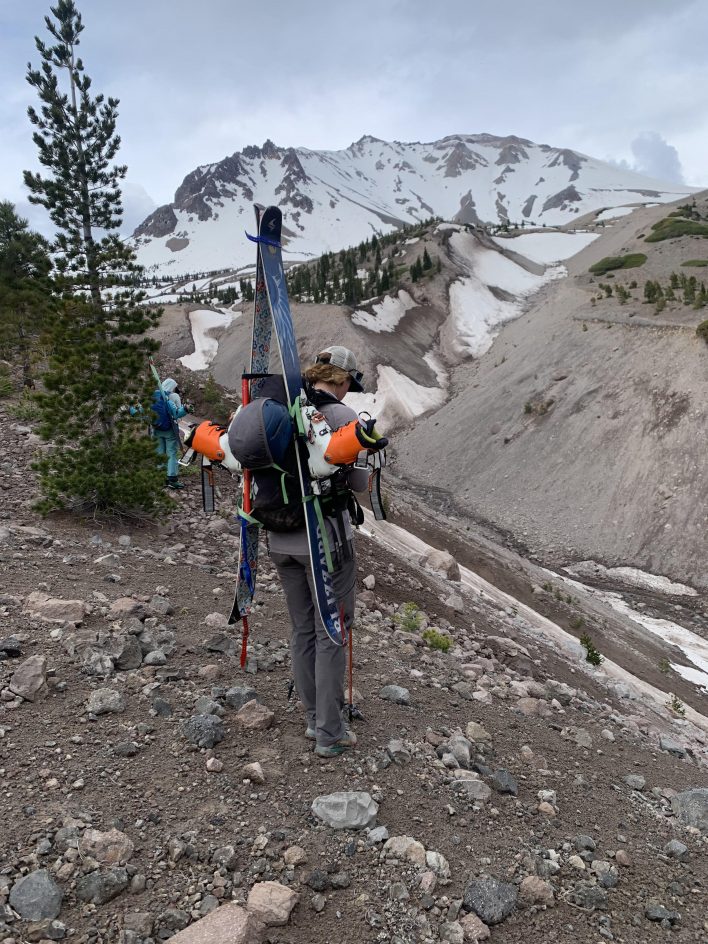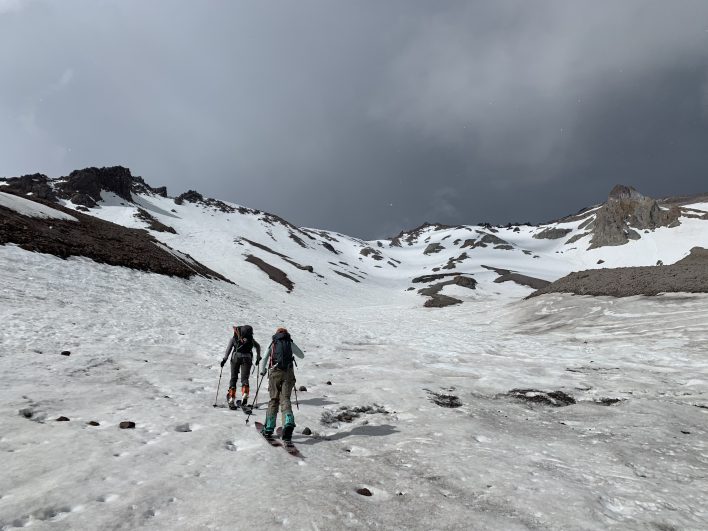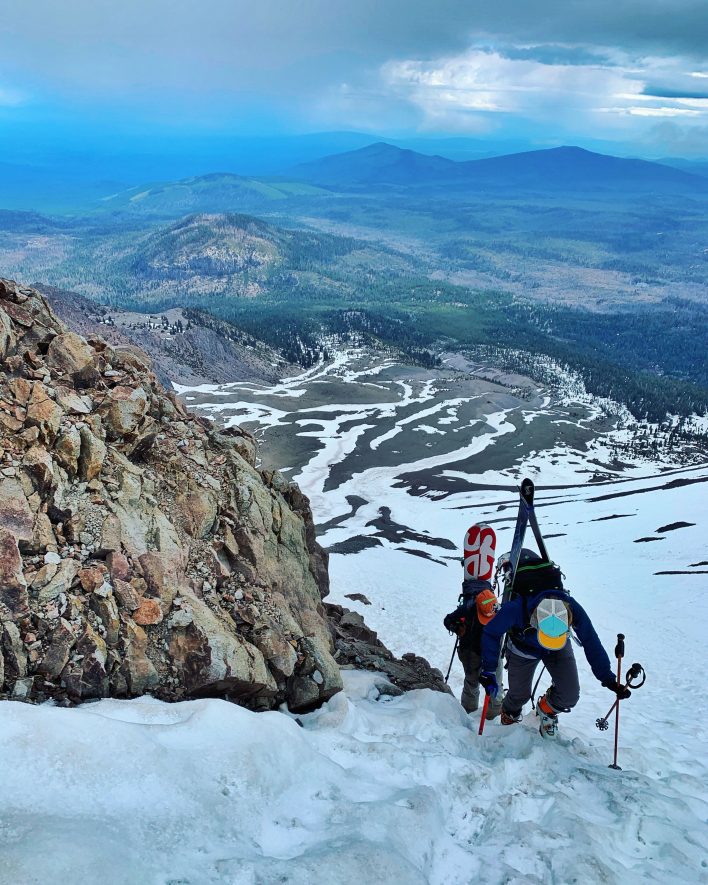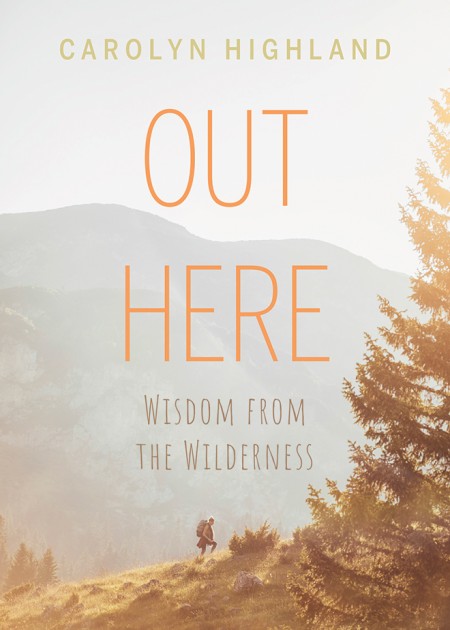We’d been bushwacking through dense pines for over an hour when we finally reached the snowline. Mt. Lassen loomed thousands of feet above us, patchier than it should have been after a lackluster winter across the West. It was mid-May, and volcano season was upon us. As with any good spring ski mission, it would involve a little bit of everything, smothered with a heavy dose of patience.

I stood on the edge of the ravine with my ski partners, Kelly and Liz, while we assessed our myriad of options. Would we descend into a ravine to our right to be able to skin up the dirty, sun-cupped snow snaking its way up the gut? Would we continue to hike across the dirt and patches and maintain our high ground? Would we bootpack across the snow up ahead or transition now and skin across? Spring skiing is a series of thousands of micro-decisions, and each option has its champions who are willing to loudly, insistently and self-righteously die on those hills.
None of us wanted to lose precious elevation, despite the fact that the white(ish) ribbon of snow in the ravine would provide us a straightforward skinning route up to where the bootpack began. Another party passed us, opting to continue to walk across the snow ahead in approach shoes, shouldering their skis and boots for a later transition.
It’s easy to mentally or vocally ridicule what you see others doing because it isn’t what you’d do. So often, on the mountain and off, we get locked into a narrow vision of what is “right.” It’s obviouslymore energy-efficient to skate across this section than to walk. Bootpacking up this pitch rather than making steep kickturns is clearly the call. It’s faster to center punch this face than gain the ridge and traverse over. We try to make nuanced decisions objective and then congratulate ourselves for being smarter or moving better than others. Or we assume because someone is doing something that they know best and we should follow suit. Did the other party know something we didn’t?
We opted to transition to skis once we reached the snow on the high ground, walking through patchy snow, dirt, and vegetation until we got there. Our plan was to contour the ravine on our skis, but within a minute the three of us had very distinct reactions. I began contouring, driving my edges into the early-morning hardpack. Behind me, Liz struggled to stay upright on her splitboard and yelled ahead that she would bootpack up to the ridge and walk until the pitch evened out. Digging my uphill pole in to stay secured to the snow, I turned around and saw Kelley following suit, shouldering her skis and kicking steps up to the ridge. I pressed on, feeling sketchier about trying to transition midslope than continuing on skins. Within a few minutes, the ravine flattened out to meet the North face of Lassen, and the three of us found ourselves next to each other again, at right about the same time.
Each decision contains certain amounts of objective and subjective factors. In some scenarios, there is a route that might be concretely safer, or more direct. But faster? Easier? More enjoyable? Those things tend to be personal and variable.
Often, each member of a party can choose the strategy that works for them, and everyone will end up where they need to be. Slick, steep skintracks are my nemesis, and I will often switch to bootpacking before other members of my team. The idea that bootpacking or skinning or walking or skating or double poling are inherently faster or better or superior can be a myth we hold in our hearts to make ourselves feel secure.

There is no painless path. No matter what we choose, no matter which line we take, no matter which mode of transportation we decide on—there will always be joy, and there will always be pain.
We encounter this phenomenon far off the skintrack all the time. We have been fed another myth that tells us that there is a correct way things need to be done, on a certain schedule, in a certain order. We are given a set of timelines, landmarks, check boxes. Get married at this age, make this amount of money, have this set of material possessions, make sure your body looks this particular way. Following this path will bring you to the peak of happiness.
In reality though, there are so many different ways to get there, and it doesn’t need to look the same for everybody. Sure, there are certain objective factors that might be the recommended route for all—be mindful of avalanche terrain and rockfall, carry safety equipment and know how to use it, communicate with your partners. Take care of your body, be kind to others, be mindful of our planet and our resources. But the rest is up to you.
Our crew was a perfect example: three women in our early 30s, none of whom were on the path that society had laid out for us. There were no spouses, no children, no owned homes among us. To stay true to herself, counseling grad student Kelley had just ended a long term partnership and was a living in a 1970s trailer named Matilda. Liz owned and ran a coffee and gelato shop on Lake Tahoe’s West Shore, lived out of her van with her dog, Mojave, and was nursing a broken heart. I was a teacher and writer who’d just published my first book and was on the continued lookout for the life/adventure partner combo after several solid tries.
Some of us wanted to be mothers, some of us didn’t, and some of us weren’t sure. We all hoped for partnerships that would nourish and challenge us. We had all achieved major milestones on our own personal lists, and we were all still reaching for things. We all felt proud of who we were and isolated from our peers because of it. We’d all sat in circles of women our age and listened to endless conversation about rings and babies and not known how to talk about adventures and heartbreaks and having to shovel our own driveways and snake our own drains and do our own taxes. How we had to pay twice as much rent for half as much space, show up to seven weddings alone each summer, not have someone to split up the driving on long road trips with, and how we’d become accustomed to the wild freedom of being able to follow your own inner compass at all times.
Somewhere along the line, we are told that certain landmarks, milestones, and accomplishments mean more than others and are more digestible by the general public. But starting your own business and consciously and lovingly ending a relationship and publishing a book are moments that should be celebrated just as much. Our paths were inevitably less frequented, less defined, and less straightforward. But what they conveniently don’t tell you is that it will also get you there.

After many more micro-decisions, made individually and as a team, we topped out on Lassen in a spring squall, fresh snow coming down heavily on the crusty re-freeze. As we transitioned out of crampons and into skis at the top, we discussed our options, and gave each other the space to do what felt best to us. It didn’t matter how we got down, as long as it was safe and felt good to us.
The visibility was poor—we could only see the first few hundred feet of the chute that would later open up into a wide apron. Kelley dropped in first, opting to side slip until the snow softened up lower down. She pulled off to the side and waited while Liz went next, staying on her heel edge with her right hand choked up on her ice axe. When they were both out of the fall line, I made slow, deliberate hop turns, pausing between each one to set up for the next. After a few minutes of careful descent, we popped out of the clouds, the lower half of Lassen sprawled out below us. The snow softened with each turn, and it wasn’t long before we found ourselves back at the dirt, heading out to the car, having successfully skied our objective.
Later that evening we lay out on a blanket in the sun next to Liz’s van, painting casual watercolors and listening to Stevie Nicks, feeling joyful and connected and alive. We were in overalls instead of formalwear, drinking cans of craft beer instead of champagne, celebrating a commitment to living the kind of life that challenged us and inspired us and took us up and down mountains rather than to another person.
Maybe we should all get to decide what The Most Important Days of Our Lives are for ourselves. Maybe they arrive on a timeline we can’t possibly predict. Maybe there are lots of them. Maybe they are already right in front of us.

Carolyn Highland is a Tahoe-based writer and outdoor educator who enjoys teaching 4th grade in ski pants, pocket cheese sticks, and deep meaningful conversations on the skintrack. Her first book, Out Here: Wisdom from the Wilderness, was released in 2020 by Rocky Mountain Books.










Related posts: